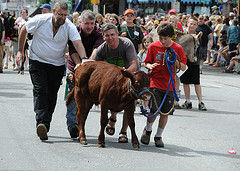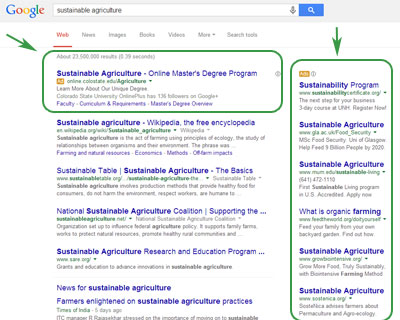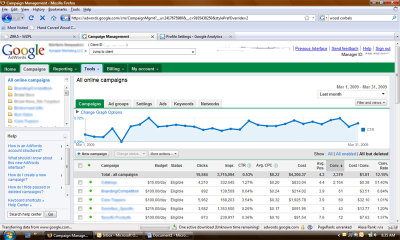One free tool that we have discussed before that can be very helpful for a nonprofit, no matter what its size, is Google for Nonprofits. In previous articles we’ve written about how nonprofits enrolled in the program can have free email using a unique name as their email domain, get free access to Google Calendar, Drive and other tools, and leverage donation buttons to raise money for their cause (on YouTube videos).
It’s easy to overlook one of the other Google for Nonprofits benefits: Google AdWords. Google AdWords is a powerful tool that allows you to advertise your organization on google.com when people search for the keywords that you choose. Google is still, by far, the world’s most popular online search engine. And, more and more, people are turning to the Internet for information before making decisions, so it’s the ideal location to start promoting your nonprofit.
Registered nonprofits are eligible for $10,000 in Google AdWord credits through a Google Ad Grant. These grants allow groups to run ad campaigns targeting specific keywords, using the $10,000 monthly credit in their account. A group’s ads will appear in at the very top of a Google search results page, or on the right hand side under “sponsored ads.” Organizations can use these ads for volunteer recruitment, raising awareness, fundraising, or to advertise events.
A helpful guide of the eligibility requirements, along with tips about creating a successful campaign, can be found in this “Quick Guide to Google Grants: Google Adwords for Nonprofits.”
 At least one Vermont nonprofit that I have advised is taking advantage of these grants to promote their cause. Brattleboro-based Strolling of the Heifers, which helps support and sustain family farms by connecting people with healthy local food and with the farmers and food producers who grow it. Each year, they host two major events: the Strolling of the Heifers and the Slow Living Summit. They have also created a well-known Locavore Index to track which states are doing the most to promote local foods.
At least one Vermont nonprofit that I have advised is taking advantage of these grants to promote their cause. Brattleboro-based Strolling of the Heifers, which helps support and sustain family farms by connecting people with healthy local food and with the farmers and food producers who grow it. Each year, they host two major events: the Strolling of the Heifers and the Slow Living Summit. They have also created a well-known Locavore Index to track which states are doing the most to promote local foods.
“We use our Google Ad Grant to promote the organization in general, plus specific events, and we try to draw some traffic to our online store,” said Martin Langeveld, Marketing Director for Strolling of the Heifers and Coordinator of the Slow Living Summit. Although he has used it successfully, he asked me to research best practices in order to make the ads even more useful.
Running a successful ad campaign can have a transformational effect on an organization: it brings in new audiences to a web site, which can drastically increase the number of people who are aware of the organization. And, by curating a campaign, a nonprofit can get very granular about who they target to get to which page, ensuring that the people who come into the site are very much interested in the topic at hand. For instance, for a food shelf, one key word, might be “help getting food,” which would show an ad dedicated to people who are searching for ways to access the food shelf’s resources. This ad would lead to a specific page on the site that explains when the food shelf is open, and what people might do to get the food.
 For a nonprofit to take full advantage of its Google Ad Grant, curators should consider where their audience lives and what keywords their target audience is likely to use to search for the organization. It is also important to be specific. A great example Google uses in their Tips for Success in Google Ad grants guide is of an organization dedicated to the protection of bears, selecting “bears” as their keyword. Their ad showed up in searches for the Chicago Bears, Bernstein Bears, and Collectible Teddy Bears among other non-related searches. Free tools such as Google’s own Keyword Planner and a host of other free and paid tools can be of tremendous help in choosing appropriate and highly searched keywords with low competition for a good price per click.
For a nonprofit to take full advantage of its Google Ad Grant, curators should consider where their audience lives and what keywords their target audience is likely to use to search for the organization. It is also important to be specific. A great example Google uses in their Tips for Success in Google Ad grants guide is of an organization dedicated to the protection of bears, selecting “bears” as their keyword. Their ad showed up in searches for the Chicago Bears, Bernstein Bears, and Collectible Teddy Bears among other non-related searches. Free tools such as Google’s own Keyword Planner and a host of other free and paid tools can be of tremendous help in choosing appropriate and highly searched keywords with low competition for a good price per click.
In order to get the most out of these campaigns, however, frequent monitoring is necessary. An organization would need to tie its Adwords account to its Analytics account, and through Analytics monitor that the traffic coming in is “sticking” on the site. It is also important to filter through keywords and ad copy regularly, removing those that are not as successful, adding more targeted copy, and adjusting the bids on each keyword.
Nonprofits can also use AdWords Express to simplify the creation and administering of Adword campaigns. This allows quick creation of campaigns, but it also has a lot less customization. (See this article for more of a comparison between Adwords and Adwords Express, as well as this article.)
 Google Ad Grants do have some limitations. From his experience, Langeveld notes that through a Google Ad Grant, “(a) you can only link to pages on your own website (so if you have other sites as we do you can’t link there, or to a third party site where you might have a registration page, etc.), (b) the bidding limit is $2, and (c), you can’t directly hawk merchandise.” As an example, he points out, “we sell cow-themed tee shirts with our organization name on them. But we can’t headline the ad ‘Cow Tee Shirt.’ We have to say something like ‘Support Farmers.’”
Google Ad Grants do have some limitations. From his experience, Langeveld notes that through a Google Ad Grant, “(a) you can only link to pages on your own website (so if you have other sites as we do you can’t link there, or to a third party site where you might have a registration page, etc.), (b) the bidding limit is $2, and (c), you can’t directly hawk merchandise.” As an example, he points out, “we sell cow-themed tee shirts with our organization name on them. But we can’t headline the ad ‘Cow Tee Shirt.’ We have to say something like ‘Support Farmers.’”
Keyword bid prices can vary depending on the term, and for Langeveld, his hopes were set to keywords costing upwards of $10 a click, which he cannot bid through Google Ad Grants. But with some creativity and an understanding of the limitations on Google Ad Grants, there is still opportunity for finding an audience appropriate to a specific organization.
While Google Ad Grants do have limitation and setting up a campaign, may seem a bit daunting, $10,000 per month of free advertising is an opportunity not to be dismissed.
A full step-by-step guide to getting started with Google Ad Grants can found here. NPG, a Burlington, VT based company that specializes in assisting nonprofits take advantage of Google Ad Grants, also has a great Slideshare presentation to walk you through every step of the process.
